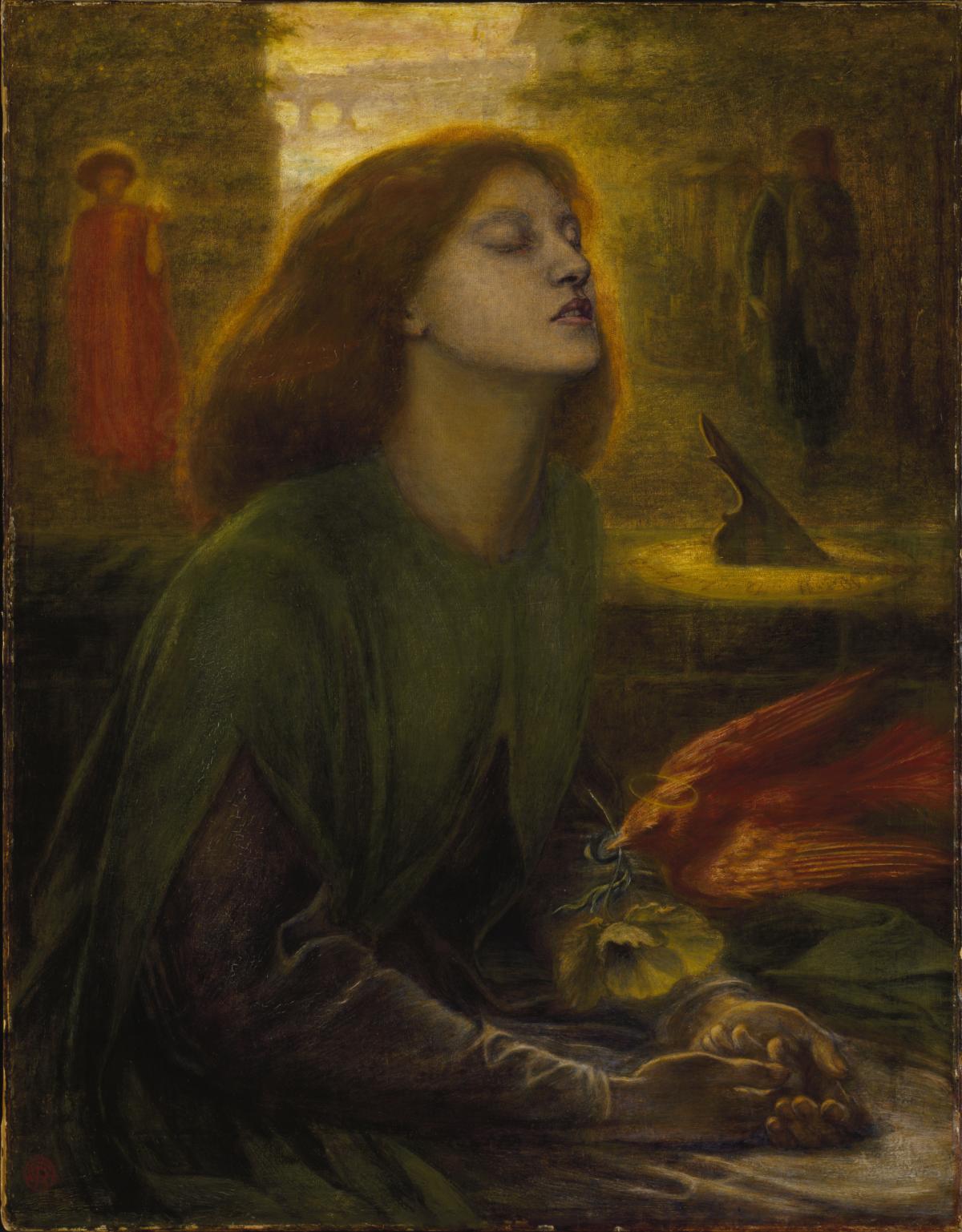A variant of this description was originally published at The Rossetti Archive at this location.
This work by Dante Gabriel Rossetti is often (and not incorrectly) read as a memorial to his wife, Elizabeth Siddal. It is more than that, however. He had begun it on canvas years before his wife's death in early 1862, as he told Ellen Heaton in a letter of 22 December 1863 (see Surtees 1.93). Drawings of all kinds from as early as 1851 develop models of this famous symbolist masterpiece. The work in fact grows from the primitive Dantean dream that enveloped DGR's imagination from an undatable early period and that he explored relentlessly in all his poetry, his translations, and his art.
When he completed the first oil version in 1870 the picture created a great stir, and various people pressed him for replicas. Ultimately he made six, each significantly different from one another, though the most important is unquestionably the oil painted for William Graham, now in the Art Institute of Chicago. The differences between these versions have not been studied as they should, nor the set considered as a coherent imaginative project. In this last respect the work has particular significance for understanding DGR's art. A common judgment takes a dim view of these replicas, and indeed of DGR's copy work in general. The financial incentives that induced him to undertake such work were considerable, and it's also true that DGR often complained about the labor involved. But it's important to recall that he was an obsessive artist who revisited and revised his writings and his pictures over and over again. The Beata Beatrix series supplies us with an important perspective on that characteristic inertia in DGR's imaginative work precisely because it is rich and complex, on one hand, and on the other because it engages a central Rossettian subject.
Production History
Various letters from DGR show that he had begun studies and even a painting of his wife Elizabeth as Dante's Beatrice sometime before her suicide-death in early 1862. DGR told Ellen Heaton in 1863 that he had "lately found" the unfinished painting and that he now wanted to finish it. At that point he imagined that, "The background of the picture should be a landscape one, introducing after the manner of the old Italian painters, scenes from Dante, bearing on its main subject" (quoted in Surtees 1.94). William Michael Rossetti dates the recommencement to 1864, and in 1870 the first oil version was completed for the Honble. William Cowper-Temple (later Lord Mount Temple).
The picture was a celebrated work from the beginning, and DGR executed a number of replicas and drawings, three in oil, a watercolour, and two in coloured chalks. The most important of these is the oil replica painted for William Graham in 1872, to which DGR added a predella.
Reception
The picture was recognized as a masterpiece from the beginning, as all the early notices show. The numerous replicas and related drawings testify to its fame as well.
Iconographic
The iconography is centrally Rossettian. The subject, imagined out of Dante, represents Beatrice in a tranced state, caught in a kind of fore-dream of her heavenly translation.
Various commentators point out that the poppy borne by the mystical bird (an Annunciation figure as well as a sign of the Holy Spirit) emblemizes death, and perhaps chastity and peace as well. The dove is both the bird of the pagan Venus and an icon of the Holy Spirit. When F. G. Stephens said of the central figure that, "She is herself a vision while . . . the heavenly visions of the New Life are revealed to the eyes of her spirit" (64), he touches on a key element of this portrait and of all DGR's portrait work. These paintings function like sacramental mediations between quotidian and supernatural orders. One recalls the dream vision painted by Chiaro in Hand and Soul: the figure stands for a supernal reality, "seen . . . but not seen of men." Stephens' other comments on the picture are also pertinent, though they do not apply to all versions: "The open window gives a view of the Arno, its bridge, and the towers and palaces of that city in which Dante and Beatrix spent their lives till the fatal month of June 1290, when she died, and, as the poet tells us, —the whole city came to be, as it were, widowed and despoiled of all dignity— . . . . In the background the poet Dante attentively regards the figure of Love, the ideal Eros of his vision, who, holding a flaming heart, passes on the other side of the picture heavenwards, and seems to sign to him that he should follow in that path" (64). Dante carries a book, presumably the Vita Nuova and stands near a well, symbolizing rebirth and the New Life that Beatrice is dreaming toward. An Arbor Vitae rises behind the figure of Love at the left background.
It is worth noting that all of the background details of this picture, including the cityscape, are much more schematically presented in the first (Tate Gallery) version than they are in other, later treatments of the subject, and particularly the oil version completed after DGR's death by Ford Madox Brown. The point is relevant when one considers the autobiographical dimensions of the work. The river, bridge, and city may be literally (or literarily) the Arno, Ponte Vecchio, and Florence, but they can and should equally be seen as the Thames and south London, with the many arches of the old Battersea Bridge spanning the river.
Pictorial
The work's traditional association with The House of Life sonnet "The Portrait" necessarily draws it into a relation with another picture, The Portrait, which DGR executed in 1869 with Jane Morris as the model. It also resembles the magnificent St. Cecilia drawing he did for the Moxon Tennyson volume.
The tranced pose of Beatrice distinctly recalls the pose DGR had Elizabeth Siddal take when she sat for his early picture The Return of Tibullus to Delia.
The picture should also be connected with DGR's drawing and watercolour of The First Anniversary of the Death of Beatrice, which pictures the incident of Dante drawing an angel, recorded in the Vita Nuova chapter XXXIV. DGR of course associated himself and his work with Dante in the closest way, so that in the case of the Beata Beatrix project, his own painting would stand as the equivalent of Dante's angel-drawing.
The picture is executed like DGR's watercolors of the 1850s rather than the oils of the 1860s, as one sees in the chalky painting surface, the undefined contours, and what Gabriele Reithmiller calls "the subdued luminosity of the colors separated from each other in compact compartments . . . to emphasize contrasting color fields" rather than to support a realistic representation.
In terms of composition, the picture illustrates a typical planarity of approach. Foreground and background are organized not by perspective but by emblematic relations. Indeed, DGR deliberately sought for an organization after the manner of what he called "the old Italian painters" (in his letter to Ellen Heaton of 19 May 1863, when he took up his work on the picture after he had set it aside). DGR's symbolist technique, so unlike the "old Italian painters," should not obscure his compositional models in primitive art.
A non-realist approach governs the deployment of light in the picture. The placement of Beatrice's head turns what is formally a realistic moment (sunlight from the distant city) into something far more emblematic. Beatrice's head is virtually in an aureole, as is the figure of Love at the left (and as Dante's, at the right, is not). The influence of stained glass lighting is very clear in a painting like this, although John Ruskin judged it to be characteristic of all his work up to the mid-60s: "Its light is not the light of sunshine itself, but of sunshine diffused through coloured glass" (33.271). Most important, the painting's inner golds connect to the outer, highly symbolic and decorative frame. The result is that the painting seems illuminated out of its own materials, and not from some imagined realistic source of light. This integration of the painting and the frame via color and symbolic paraphernalia dramatizes the simplicity of the symbolical character of the color organization of the work—a "sombre harmony of gold and green and purple," as Evelyn Waugh noted (122). The white underpainting, notable at the lower right and in Beatrice's sleeves, lends a strange luminosity to the largely darkened space dominated by the figure of Beatrice, and is an important element contributing to the work's power of spiritual suggestion.
Literary
While the picture has often been linked toThe House of Life sonnet "The Portrait," there is no explicit indication that DGR regarded the sonnet and picture as comprising a "double work".
The Dantean connection, to the Vita Nuova, is one that DGR imagined for the picture from its earliest states, as we see from his various letters about the work (e.g., to The Hon. Mrs. Cowper-Temple, 26 March 1871, and to Ellen Heaton, 19 May and 22 December 1863). Compare in particular Dante's canzone in the Vita Nuova section XXXI ("Li occhi dolenti per pieta del core," lines 24-28), which is translated by DGR as "The eyes that weep for pity of the heart" (see lines 23-28). The flaming heart in Love's hand is of course a recollection of the first sonnet ("A ciascun alma presa") in Dante's symbolistic autobiography (see DGR's translation).
Autobiographical
DGR always regarded the Beata Beatrix project as a kind of memorial to his dead wife. She was the model for the first oil version, but later replicas clearly move toward a more abstract treatment of Beatrice's face. Although earlier scholars were unaware of the fact, DGR had done considerable work on the painting before his wife's suicide in 1862. The painting was therefore invested with deep personal, and more particularly Dantean, qualities for DGR. That is to say, DGR would have been able to see the painting as a kind of prophetic construction of Elizabeth as Beatrice, whose death assumed mythic significance for Dante. Moreover, in this version of the painting the cityscape background could as well suggest the Thames, the old Battersea Bridge, and south London viewed from Cheyne Walk as it could the Arno, the Ponte Vecchio, and the skyline of Florence viewed from Beatrice's father's house.
As so often with DGR's mythic imaginations, however, he also saw his other great love, Jane Morris, in the figure of Beatrice, as we know most directly from the exquisite watercolor he did of her in 1872, Jane Morris as Beatrice (Lady in a Blue Dress).
Works Cited
Ruskin, John. The Works of John Ruskin. Vol. 33. Ed. Edward Tyas Cook and Alexander Wedderburn. Cambridge: Cambridge UP, 2010.
Stephens, F. G. Dante Gabriel Rossetti. Seeley and Co., 1894.
Surtees, Virginia. Painting and Drawings of Dante Gabriel Rossetti: A Catalogue Raisonné. vol. 1. Oxford: Oxford UP, 1971.
Waugh, Evelyn. Rossetti: His Life and Works. Gerald Duckworth & Co., 1975.
How to Cite this Web Page (MLA format)
McGann, Jerome. "Dante Gabriel Rossetti, Beata Beatrix (1864-1870)." Omnibus Edition of "In an Artist's Studio. Eds. Pamela Buck, Dino Franco Felluga, Nicole Fluhr, Dominique Gracia, Jerome McGann, Melissa Merte, and Herbert F. Tucker. The COVE: The Central Online Victorian Educator, covecollective.org. [Here, add your last date of access to The COVE].



